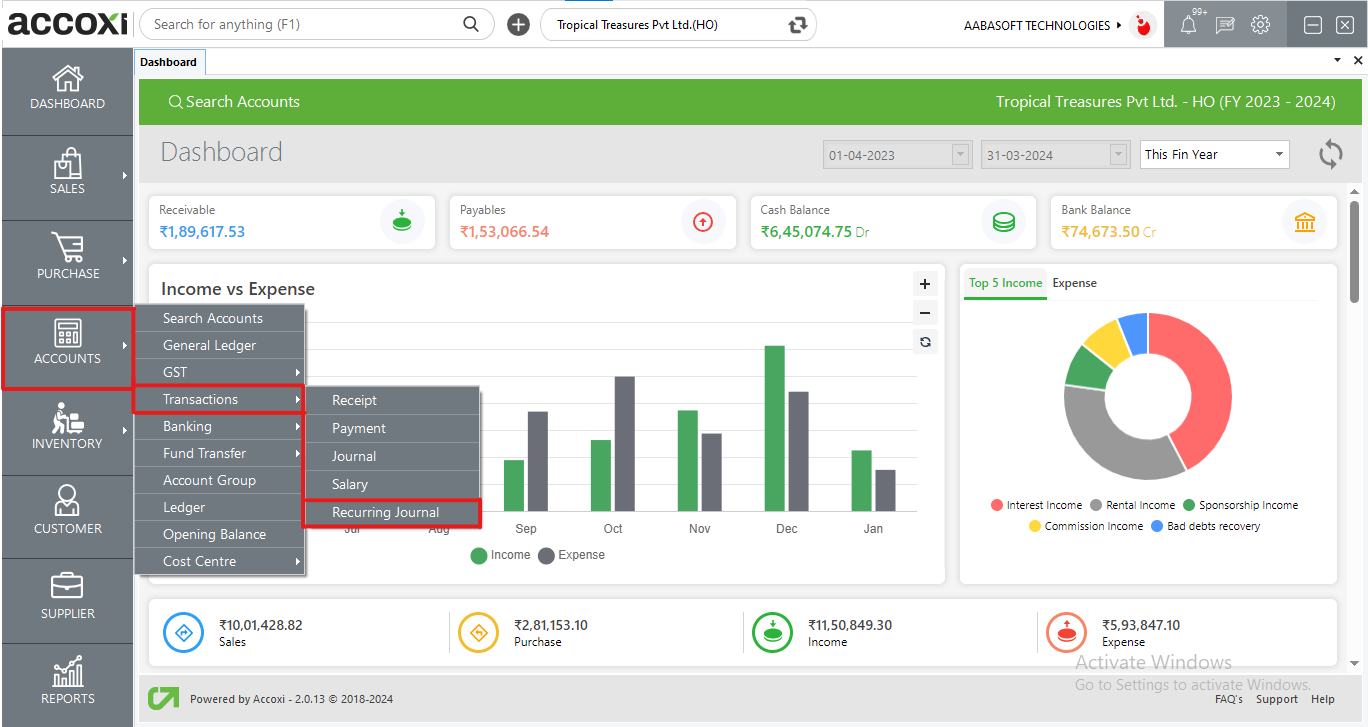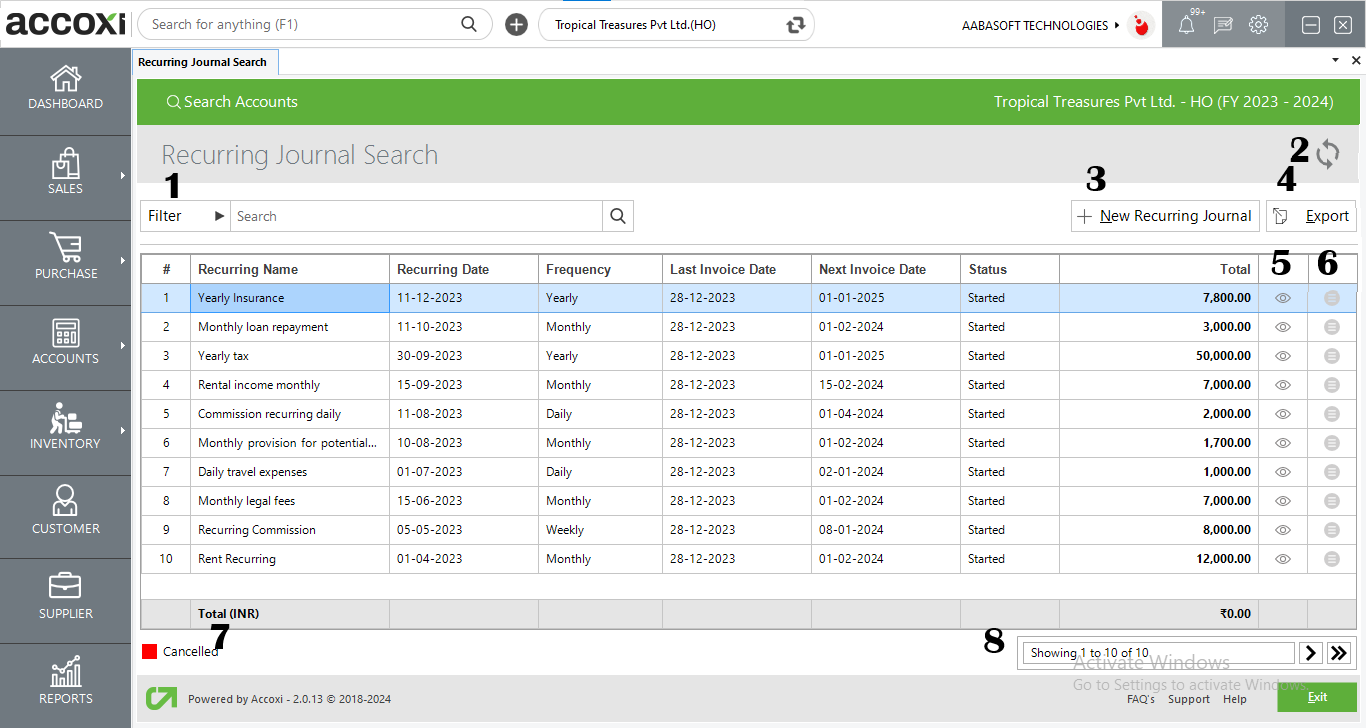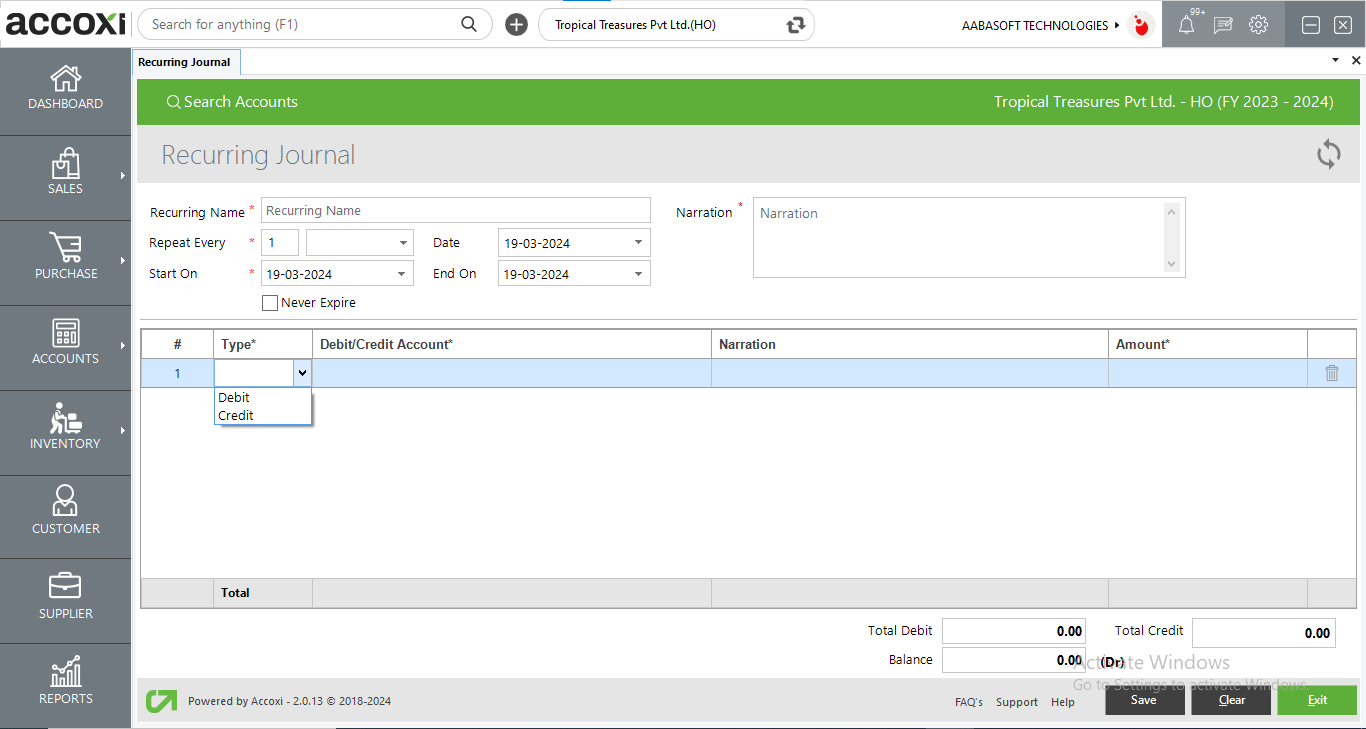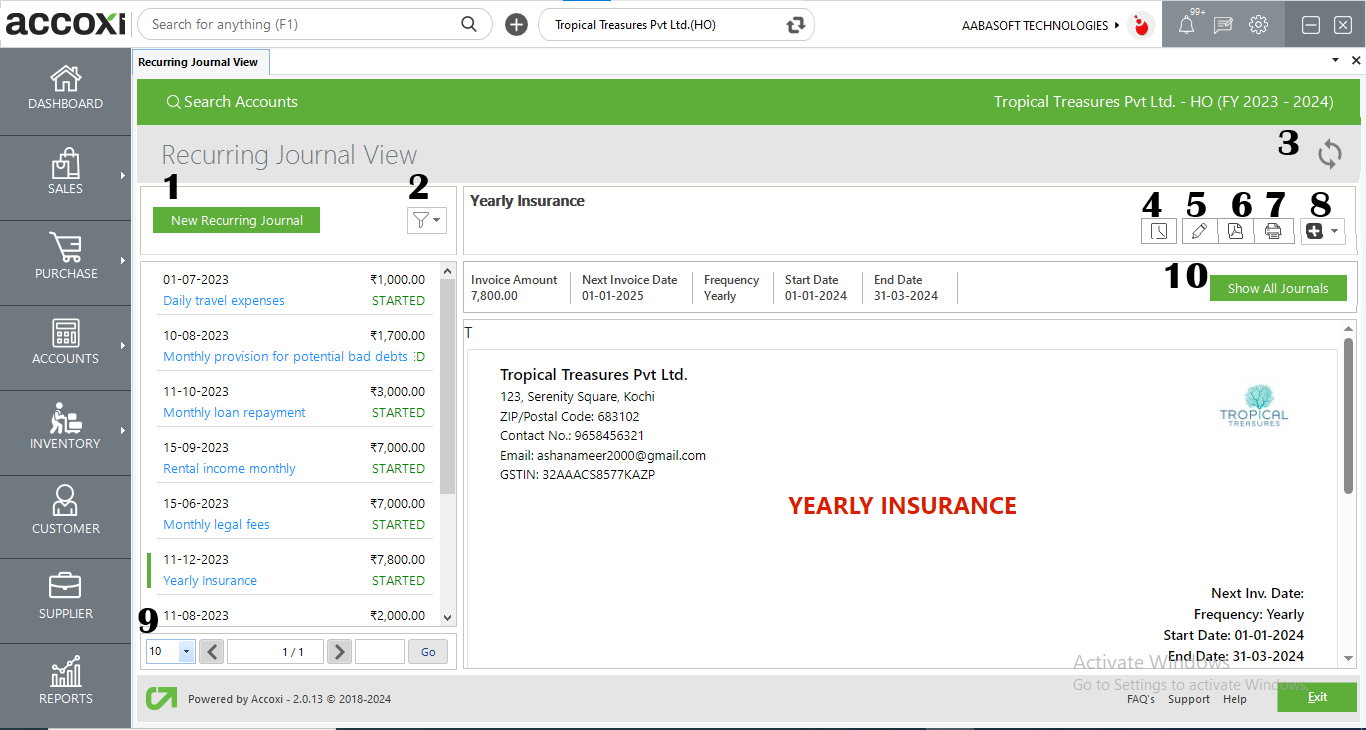
Navigating through the recurring journal entry of Accoxi
A recurring journal refers to a systematic and repetitive financial record-keeping practice where specific journal entries are automatically generated and posted at regular intervals. This can streamline the accounting process for transactions that occur routinely, such as monthly rent payments, subscription fees, or depreciation expenses. Recurring journals help ensure consistency and accuracy in financial reporting by automating the recording of repetitive transactions over time.

Key Feature:

RECURRING JOURNAL SEARCH

Contents Available in Recurring Journal Search:
|
Field |
Description |
|
1.Filter |
The filtering of transactions can be accomplished in two ways: either by directly entering the recurring name into the search bar near the filter option or by clicking the filter dropdown. Users have the flexibility to filter data by recurring name, status, or date. If the transaction data is filtered using the date format, users need to enter the starting date and the end date of the transactions. |
|
2.Refresh |
If the most recent data is not visible, simply click on the refresh icon located at the top-left corner of the page to retrieve the latest information. |
|
3.+ New Recurring Jornal |
The +new recurring journal option allows users to create a new recurring journal, directing them to the recurring journal creation window. |
|
4. Export |
To export the journal list to an excel format, click the export button located at the top-right corner near the +new recurring journal button. Choose the file location and click on save. |
|
5. View Icon |
The view menu allows the user to view the recurring journal invoice that has already been created. |
|
6. More option |
This Menu Includes An Edit Function, export to PDF, print and view. If The User Wants To Edit The Created Form, It Can Be Done By Using This Menu. After Clicking The Edit Option, The Invoice Form Will Appear On The Screen. |
|
7. Color filter |
Cancelled recurring journals are displayed in red. |
|
8. Pagination control |
It manages page navigation and size in the journal section. Users can set the page size to 10, 20, 50, or 100. By entering the page number in the box and clicking on the go button, it navigates to the specified page. |
To initiate the creation of a new recurring journal entry, adhere to the following steps:

|
Field |
Description |
|
Recurring Name |
Enter the name for the recurring transaction. |
|
Repeat Every |
The "Repeat Every" field allows you to specify the frequency of the recurring transaction. For example, if the transaction needs to be generated every day, you can set it as follows: Repeat Every 1 Day. |
|
Date |
Choose the date for the recurring journal. By default, the current date will be displayed. |
|
Start On |
The "Start On" field represents the date when the automatic generation of the transaction is scheduled to commence. |
|
End On |
The "End On" field indicates the date when the automatic generation of the journal is intended to come to an end. |
|
Never Expire |
You have the option to configure the journal transaction generation to never expire, ensuring that it continues indefinitely. |
|
Narration |
The user can enter narration for the journal entry in this field. |
|
# |
This refers to the numerical order or sequence of items in a table. |
|
Type |
The user has the option to choose between a debit or credit type for the journal entry. |
|
Debit/Credit Account |
The user should input the debit or credit account, which encompasses all the ledgers created and accounts of suppliers and customers. |
|
Narration |
The user can then input narration corresponding to the account. |
|
Amount |
The user can enter the amount in the corresponding debit/credit columns, but the debit and credit aspects should be equal; otherwise, a validation message will pop up. |
|
Delete |
The delete option can be used to remove line entries. |
|
Total Debit |
It indicates the total debit amount in the journal. |
|
Total Credit |
This column displays the total credit amount in the journal. |
|
Balance |
The difference between debit and credit is shown in this column. If the difference is in the debit aspect, it shows a (dr.) Balance, and if the difference is in the credit aspect, it shows a (cr.) Balance. The voucher cannot be saved if there is any imbalance. To save the voucher, the debit and credit sides should match. |
|
Save |
By clicking "save," the journal entered by the user will be saved, and it will be visible in the transaction menu. Users can track the journal using the reference number of the journal. |
|
Clear |
To clear the data entered in the journal window, this option can be used. |
|
Refresh |
If your latest data is not displayed, click on the refresh icon on the top left corner of the page to fetch the new data. |
|
Exit |
To close the journal window without saving, users can click the exit button. |
RECURRING JOURNAL VIEW

|
Field |
Description |
|
1. New Recurring Journal |
Opting for the "New Recurring Journal" option directs the user to the window for creating a new Recurring Journal, and the Recurring Journal form will be displayed upon clicking this option. |
|
2. Filter |
The filter menu enables users to categorize recurring journal data by different statuses, including "All," "Started," "Expired," and "Cancelled" through a dropdown list. The list of orders displayed on the left side of the view window should be organized based on the chosen filtering condition. |
|
3. Refresh |
If the latest data is not displayed, users can click on the refresh icon located at the top left corner of the page to fetch the new data. |
|
4. History |
The history window provides users with details of edits and alterations made to the recurring journal. It includes comments and a chronological record of changes, allowing users to input comments related to the journal entries. |
|
5. Edit |
The edit menu allows the user to edit or correct the details that have been entered in the transaction. |
|
6. Export to PDF |
If The User Wants To Convert The Journal To PDF Format, The Export To PDF Option Is Available. After Clicking Export To PDF, A Save As Directory Option Will Appear, And The User Can Choose The PDF File Saving Location. |
|
7. Print |
The Print Menu Helps The User To Print The Journal If Required. After Clicking The Print Button, It Will Redirect To Print Options Where The User Can Select The Printer, Number Of Copies To Take, Etc. |
|
8. + More Option |
In the more features option, users can cancel the payment. By clicking cancel, a validation message will pop up. Then click "yes" to cancel the payment and click "no" to cancel and close the option. Also you can create duplicate recurring journal by clicking on duplicate feature available in more function. |
|
9. Pagination control |
This feature controls the page navigation and the page size. The page size can be set to 10, 20, 50, or 100. By entering the page number in the box and clicking the go button, it jumps to the specified page. |
|
10. Show All Journals |
By clicking on this button, you can access a view of all journals created under this recurring journal transaction. |